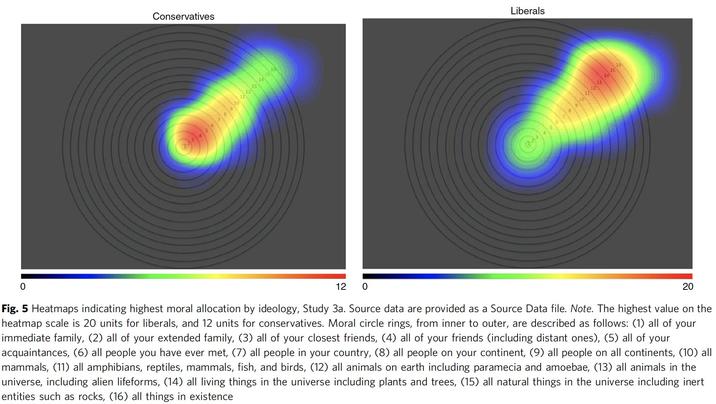Guides
What Does The 'Moral Circles' Heatmap Mean And How Accurate Is It? Analyzing The 'Opinion Dismissed' Chart
Memes showing two heatmap charts with 20 concentric circles each, one tagged "conservatives" and the other "liberals," have been appearing in political discussions on X / Twitter lately, with right-wingers using the heatmap to imply that liberals care more about strangers and animals than about their immediate family.
So where do these charts come from, what do they show exactly, and how accurate are they? Learn all of these in our explainer.

What Is The Moral Circles Heatmap Chart?
Moral Circles Heatmap refers to two heatmap charts of moral allocation distribution done by conservative and liberal participants. The charts, in which the larger rings also include the smaller rings, reflect how conservatives and liberals distribute their moral regard.
The results of the study, visualized as a heatmap, revealed that liberal participants tended to include non-humans within the extent of their moral concern, with the highest value on the heatmap falling in the "all living things in the universe including plants and trees" range.
Meanwhile, conservative respondents tended to give more parochial replies, with the highest value on their heatmap falling within the "all of your friends (including distant ones)" range.

Where Does The Moral Circles Heatmap Come From?
The heatmaps come from a sociological study titled "Ideological differences in the expanse of the moral circle," authored by Adam Waytz and several others, which was published on September 26th, 2019, and is currently freely available online.
In the paper, the study in question can be found as "Study 3a." The paper also includes a full description of the procedure used for the study and the form that was provided to the respondents.
How Was The Study Done And How Accurate Is It?
The Study 3a published had 130 United States residents including 64 liberals, 31 moderates and 36 conservatives with a median age of 36 completing a moral allocation task. The participants allocated 100 "moral unites" among 16 categories, pictured as increasingly large concentric circles, ranging from "all of your immediate family" to "all things in existence."
Importantly, the instructions for the task clarified that the selected number included the numbers below it as well, meaning that larger circles (such as number 10 "all mammals") also included smaller circles 1 to 9 ("all of your immediate family," "all people you have ever met," etc.).

In the paper, researchers mention that there was an issue that might have affected the results of the study. As participants were limited to 100 "moral units" to allocate, they were forced to sacrifice certain circles for the sake of other ones.
To remedy this, an additional study found in the same paper was done by the same researchers, with their final conclusion being, "these findings demonstrate that liberals and conservatives differ not in the total amount of moral regard per se but rather they differ in their patterns of how they distribute their moral regard."

How Is The Moral Circles Heatmap Used In Memes?
Online, the heatmaps have been used to imply that liberals care less for their immediate family and friends than for strangers, migrants and humanity as a whole, with some posts going as far as to imply that liberals concern themselves more with inanimate objects than with humans.

By late 2024, the charts gained enough online recognition that some users resorted to posting them, especially the "liberal" version, out-of-context. However, the argument they have been used to illustrate stayed the same as before.

In January 2025, a photograph of a steak and an avocado laid out on two plates (symbolizing the conservatives and the liberals, respectively) so that it resembled the charts achieved particular popularity as a reaction.

For the full history of the Moral Circles Heatmap, be sure to check out Know Your Meme's encyclopedia entry for more information.
